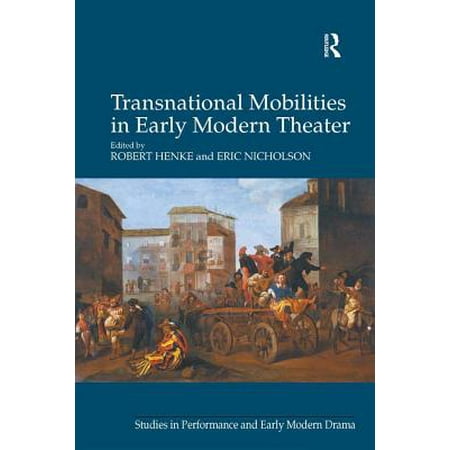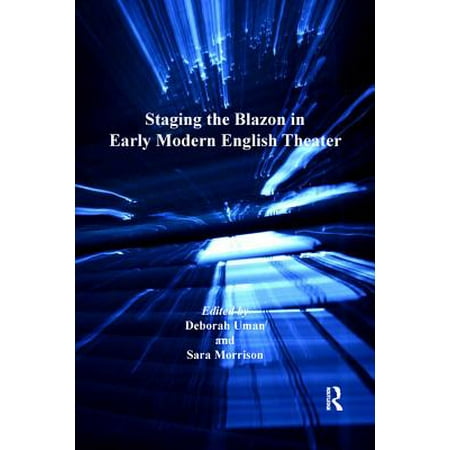Costuming the Shakespearean Stage: Visual Codes of Representation in Early Modern Theatre and Culture (Studies in Performance and Early Modern Drama)
Bestseller #1 Costumes In Early Modern Theatre
Information
Although scholars have long considered the material conditions surrounding the production of early modern drama, until now, no book-length examination has sought to explain what was worn on the period's stages and, more importantly, how articles of apparel were understood when seen by contemporary audiences. Robert Lublin's new study considers royal proclamations, religious writings, paintings, woodcuts, plays, historical accounts, sermons, and legal documents to investigate what Shakespearean actors actually wore in production and what cultural information those costumes conveyed.Four of the chapters of Costuming the Shakespearean Stage address 'categories of seeing': visually based semiotic systems according to which costumes constructed and conveyed information on the early modern stage. The four categories include gender, social station, nationality, and religion. The fifth chapter examines one play, Thomas Middleton's A Game at Chess, to show how costumes signified across the categories of seeing to establish a play's distinctive semiotics and visual aesthetic.
Hamilton: One Shot to Broadway
Bestseller #2 Costumes In Early Modern Theatre
Information
Spectacular Performances: Essays on theatre, imagery, books, and selves in Early Modern England
Bestseller #3 Costumes In Early Modern Theatre
Information
Why did Queen Elizabeth I compare herself with her disastrous ancestor Richard II? Why would Ben Jonson transform Queen Anne and her ladies into Amazons as entertainment for the pacifist King James? How do the concepts of costume as high fashion and as self-fashioning, as disguise and as the very essence of theatre, relate to one other? How do portraits of poets help create the author that readers want, and why should books, the embodiment of the word, be illustrated at all? What conventions connect image to text, and what impulses generated the great art collections of the early seventeenth century? In this richly illustrated collection on theatre, books, art and personal style, the eminent literary critic and cultural historian Stephen Orgel addresses himself to such questions in order to reflect generally on early modern representation and, in the largest sense, early modern performance. As wide-ranging as they are perceptive, the essays deal with Shakespeare, Jonson and Milton, with Renaissance magic and Renaissance costume, with books and book illustration, art collecting and mythography.
Disguise on the Early Modern English Stage (Studies in Performance and Early Modern Drama)
Bestseller #4 Costumes In Early Modern Theatre
Information
Disguise devices figure in many early modern English plays, and an examination of them clearly affords an important reflection on the growth of early theatre as well as on important aspects of the developing nation. In this study Peter Hyland considers a range of practical issues related to the performance of disguise. He goes on to examine various conceptual issues that provide a background to theatrical disguise (the relation of self and "other", the meaning of mask and performance). He looks at many disguise plays under three broad headings. He considers moral issues (the almost universal association of disguise with "evil"); social issues (sumptuary legislation, clothing, and the theatre, and constructions of class, gender and national or racial identity); and aesthetic issues (disguise as an emblem of theatre, and the significance of disguise for the dramatic artist). The study serves to examine the significant ways in which disguise devices have been used in early modern drama in England.
Costumes and Scripts in the Elizabethan Theatres
Bestseller #5 Costumes In Early Modern Theatre
Information
This book examines the ways in which costumes were acquired and used in conjunction with the repertory of the principal London acting companies, mainly during the years 1594-1621.
Transnational Mobilities in Early Modern Theater - eBook
Costumes In Early Modern Theatre
Benefits
The essays in this volume investigate English, Italian, Spanish, German, Czech, and Bengali early modern theater, placing Shakespeare and his contemporaries in the theatrical contexts of western and central Europe, as well as the Indian sub-continent. Contributors explore the mobility of theatrical units, genres, performance practices, visual images, and dramatic texts across geo-linguistic borders in early modern Europe. Combining 'distant' and 'close' reading, a systemic and structural approach identifies common theatrical units, or 'theatergrams' as departure points for specifying the particular translations of theatrical cultures across national boundaries. The essays engage both 'dramatic' approaches (e.g., genre, plot, action, and the
Staging the Blazon in Early Modern English Theater - eBook
Costumes In Early Modern Theatre
Benefits
Offering the first sustained and comprehensive scholarly consideration of the dramatic potential of the blazon, this volume complicates what has become a standard reading of the Petrarchan convention of dismembering the beloved through poetic description. At the same time, it contributes to a growing understanding of the relationship between the material conditions of theater and interpretations of plays by Shakespeare and his contemporaries. The chapters in this collection are organized into five thematic parts emphasizing the conventions of theater that compel us to consider bodies as both literally present and figuratively represented through languge. The first part addresses the dramatic
Poverty and Charity in Early Modern Theater and Performance
Costumes In Early Modern Theatre
Benefits
Whereas previous studies of poverty and early modern theatre have concentrated on England and the criminal rogue, Poverty and Charity in Early Modern Theatre and Performance takes a transnational approach, which reveals a greater range of attitudes and charitable practices regarding the poor than state poor laws and rogue books suggest. Close study of German and Latin beggar catalogues, popular songs performed in Italian piazzas, the Paduan actor-playwright Ruzante, the commedia dell’arte in both Italy and France, and Shakespeare demonstrate how early modern theatre and performance could reveal the gap between official policy and actual practices regarding the
Watch Costumes In Early Modern Theatre Video Review
Working In The Theatre: Costumes







